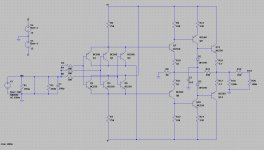Hi Everyone,
I've bought PCBs for a Accuphase C-245 clone as a both preamp and test mule for the future. See below (they seem to be as exact to the service manual):
https://www.ebay.com/itm/353711582608
I'm new to discrete design. As you all probably can guess, it uses EOL transistors. Since they are hard to find and as an exercise, I've decided to swap them for newer parts. As far as I was able to check here are equivalents (they are on the example of line amp section):
2SC2875 (low noise and nice linearity) -> BC550 (and PNP equivalents)
2SC3329 (extremely low noise and low Rbb') -> BC550 (and PNP equivalents)
2SC1845 (output follower) -> KSC1845 (and PNP equivalents)
1SR139-400 - output follower biasing diodes -> 1N4148
I decided to play around each part of the circuit in LTSpice to see how it performs, check stability, noise etc. Sadly, the circuit doesn't bias properly. First stage (I know that first and stage are actually one as it is a diamond buffer) spot on. Second stage around where it should be (below 0,2mA according to manual), but then third (VAS) and fourth are way off (basically turned off). When I tried to get it biased properly I discovered that when I bumped input followers bias (app.: 3x) everything started to get normal.
That leads me to belive that my chosen transistors aren't exact equivalents. My thought is that a higher Vbe of BC550 might cause not enough juice in later stages. Or maybe it's my lack of understanding of diamond buffer.
My idea of biasing in this circuit:
Q1/3/5 are biased by resistor R6 = ((V+ - V-) - Vbe )/R6
Q7 is biased by Q1/3/5 emitter voltage which is their Vbe (as their bases are at GND potential) Vbe(Q1/3/5) = Vbe(Q5) + V(R10)
Q9 is biased by R9 as V(R9) = Vbe(Q9)+ V(R13), R13 also serves to make VAS more linear
Q11 is biased by voltage drop on diodes as V(D1) + V(D2) = 2Vbe + V(R16) + V(R17)
I've bought PCBs for a Accuphase C-245 clone as a both preamp and test mule for the future. See below (they seem to be as exact to the service manual):
https://www.ebay.com/itm/353711582608
I'm new to discrete design. As you all probably can guess, it uses EOL transistors. Since they are hard to find and as an exercise, I've decided to swap them for newer parts. As far as I was able to check here are equivalents (they are on the example of line amp section):
2SC2875 (low noise and nice linearity) -> BC550 (and PNP equivalents)
2SC3329 (extremely low noise and low Rbb') -> BC550 (and PNP equivalents)
2SC1845 (output follower) -> KSC1845 (and PNP equivalents)
1SR139-400 - output follower biasing diodes -> 1N4148
I decided to play around each part of the circuit in LTSpice to see how it performs, check stability, noise etc. Sadly, the circuit doesn't bias properly. First stage (I know that first and stage are actually one as it is a diamond buffer) spot on. Second stage around where it should be (below 0,2mA according to manual), but then third (VAS) and fourth are way off (basically turned off). When I tried to get it biased properly I discovered that when I bumped input followers bias (app.: 3x) everything started to get normal.
That leads me to belive that my chosen transistors aren't exact equivalents. My thought is that a higher Vbe of BC550 might cause not enough juice in later stages. Or maybe it's my lack of understanding of diamond buffer.
My idea of biasing in this circuit:
Q1/3/5 are biased by resistor R6 = ((V+ - V-) - Vbe )/R6
Q7 is biased by Q1/3/5 emitter voltage which is their Vbe (as their bases are at GND potential) Vbe(Q1/3/5) = Vbe(Q5) + V(R10)
Q9 is biased by R9 as V(R9) = Vbe(Q9)+ V(R13), R13 also serves to make VAS more linear
Q11 is biased by voltage drop on diodes as V(D1) + V(D2) = 2Vbe + V(R16) + V(R17)
